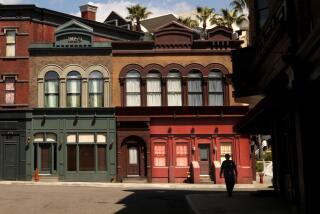COLOR NEW ‘34TH STREET’ MIRACLE OF TECHNOLOGY
- Share via
A group of technicians called “colorists” have been working three shifts a day in a Hollywood office building turning the 1947 black-and-white movie classic “Miracle on 34th Street” into the 1947 color classic “Miracle on 34th Street.”
Using photo-enhancement computer technology arising out of the space program, the colorists hope to breathe new commercial life into thousands of films and television programs shot before the wide-spread use of color film or videotape.
Bits of the colorists’ work already have been seen by millions of people, but the color version of “Miracle,” scheduled to make its television debut Sunday (4 p.m. on Channel 13), is their first completed feature-length project. Still to come are color versions of “Yankee Doodle Dandy,” “Camille,” the 1935 “Mutiny on the Bounty” and the 1941 “Dr. Jekyll and Mr. Hyde.”
“I think ‘Miracle’ is going to have a whole new generation of people looking at it,” said Charles M. Powell, executive vice president of Color Systems Technology Inc. “It’ll be our best foot forward.”
More precisely, Powell and associates Ralph Weinger and Buddy Young hope that “Miracle” will be their company’s best 94 minutes forward. They hope the movie will show that the prime-time television and videocassette audience will flock to more modern-looking versions of films that, over the years, have lost much of their broad appeal.
The group acknowledges that what they are up to may send film purists up the wall, but they believe that the popular audience, having grown accustomed to color television, will welcome their efforts.
“We will be criticized by every cultist-purist in the country,” said Young, president of the firm, “but more people will like the new versions.”
The coloring of black-and-white film footage has been an evolving craft for nearly eight years, since process inventor and company chairman Weinger converted six minutes of documentary newsreel footage included in the 1978 NBC television movie “King.” The next year, ABC’s “Ike” miniseries used 26 minutes of converted footage.
Last year portions of old “Twilight Zone” programs were converted by Toronto-based Colorization Inc., a subsidiary of Hal Roach Studios in Los Angeles.
Color Systems converted the opening sequences of the revived “Alfred Hitchcock Presents” currently on NBC.
Both the Colorization and Color Systems conversion processes are the offsprings of a blend of artistic, video and computing skills. All come together in the colorist, who sits at a computer console second-guessing how a director would have shot a scene if he or she had worked in color rather than black and white.
“There’s never been something called a ‘colorist’ before,” explained Young, who said that Color Systems first set out to hire persons with artistic backgrounds and then learned that they needed artists with video and computer skills as well. Now the firm is designing its own aptitude test and training program for its recruits.
Essentially, the colorist transfers a movie to videotape and then monitors it scene by scene, ordering the computer to fill in colors according to a palette selected ahead of time. Expensive frame-by-frame coloring is unnecessary because the computer remembers the pre-determined color scheme, and the colorist must pay attention only to those elements of the picture that change.
The work is hardest when a scene includes a great deal of movement. The company converted portions of a Three Stooges film and found that their frenetic visual style proved time-consuming and difficult to convert.
“I wish to God there was only one Stooge,” said Powell. “ ‘Whose Life Is It Anyway?’ (where most of the film involves a patient in a hospital bed) would be a lot easier.”
Within scenes, however, most movies have relatively little movement. According to one estimate, less than 5% of the image in an average film changes from frame to frame. That makes the coloring process relatively easy.
In one scene from “Miracle,” for example, Edmund Gwenn is speaking with young Natalie Wood. Wood remains still, and the set remains the same throughout the scene. The only changes of concern to the human colorist occur as Gwenn moves across the room.
The colorist directs the computer to change the color of Gwenn frame by frame as he moves, but the computer remembers to keep everything else in the picture constant. The color version uses the same shading and lighting as the original black and white.
If the same set appears in a later scene, the computer remembers the originally selected colors, and there is no need for the colorist to repeat the instructions for the new scene.
Color Systems can color six to eight minutes of black-and-white film a day and spent about eight weeks working on “Miracle.”
That time frame does not include the company’s extensive research intended to make sure that the movie closely approximates what it might have looked like had director George Seaton shot in color originally. “Macy’s (department store) opened up its entire archives to us for research,” Young said.
The result is a color tone of “Miracle” that looks very much like the 1940s, not the 1980s. Although the firm could have made the color version of the movie look just about any way the colorists wished--all the way up to glaring 1950s-era Technicolor--Color Systems is trying to maintain the movie’s historical character.
More to Read
Only good movies
Get the Indie Focus newsletter, Mark Olsen's weekly guide to the world of cinema.
You may occasionally receive promotional content from the Los Angeles Times.










